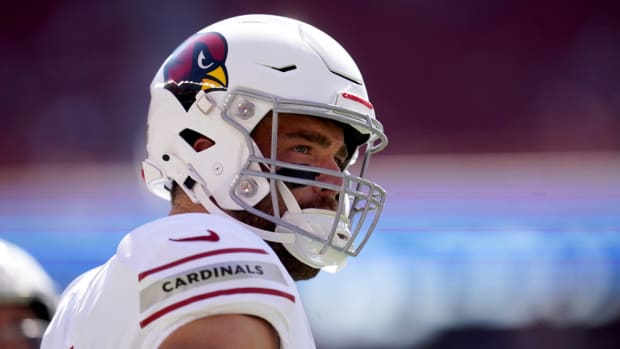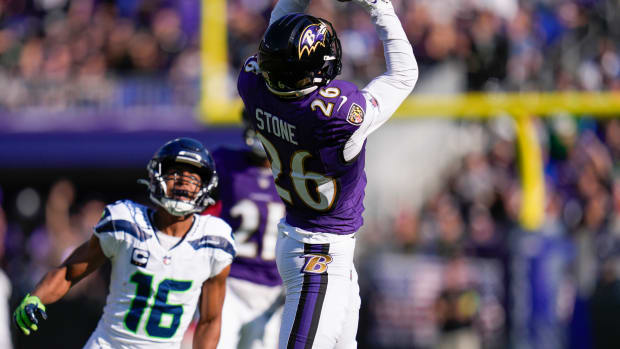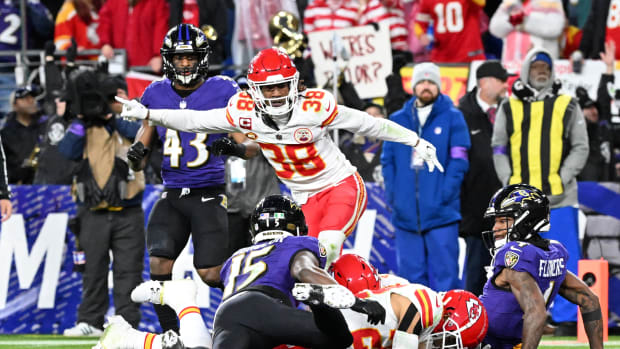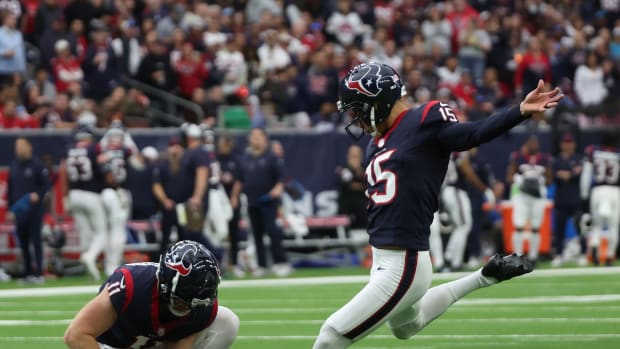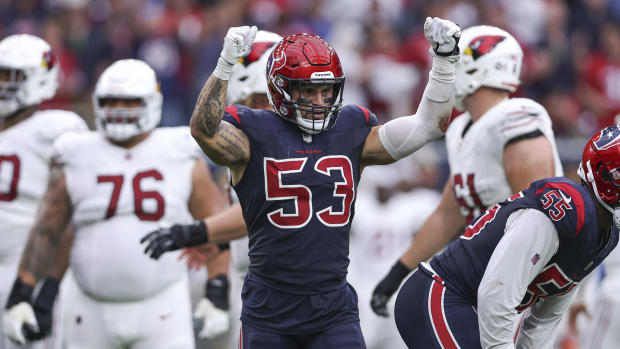
Miami Dolphins Fantasy Football 2017 Preview: Savor Jay Ajayi's Volume
Adam Gase developed a reputation as a quarterback whisperer after coaxing career-best seasons from Peyton Manning and the notoriously indifferent Jay Cutler. Gase may indeed be a QB-friendly coach, but his record shows that he’s a hardcore devotee of the ground game.
In his four seasons running NFL offenses—two as Denver’s offensive coordinator, one as Chicago’s offensive coordinator and one as Miami’s head coach—Gase’s teams have ranked 11th, 12th, 6th and 18th in number of rushing attempts. And while the Dolphins only ranked 18th in number of running plays last year, they were more run-heavy than that figure suggests, ranking fifth in team running play percentage.
Running Backs
PLAYER | ADP | FITZ RANKING | ADVICE |
Jay Ajayi | RB7 | RB6 | Savor the volume |
Regardless of how you feel about Jay Ajayi as a fantasy commodity, you have to admit it’s pretty cool that the NFL has a star running back with a British accent. If I draft Ajayi on any of my teams, I’m going to start including black pudding, baked beans and a grilled tomato with my breakfast on football Sundays.
How strange that at one point early last season, Ajayi was stuck in an unwieldy four-way RB committee with Kenyan Drake, Damien Williams and Isaiah Pead. I mean, really … Isaiah Pead? Ajayi seized control of the Miami backfield with a 204-yard rushing game against the Steelers in Week 6, followed it up with 214 rushing yards against the Bills in Week 7, then tacked on a 206-yard rushing game against the Bills in Week 16 for good measure. Ajayi became only the fourth running back in NFL history to run for 200 or more yards three times in a season, joining O.J. Simpson, Earl Campbell and Tiki Barber.
Volume is a huge selling point for Ajayi. He averaged 20.8 carries over Miami’s final 11 regular-season games of 2016 and faces no real competition for carries this year. There’s also been chatter that the Dolphins want Ajayi to be more involved in the passing game. That doesn’t seem too far-fetched when you consider that Ajayi had 50 receptions in his final season at Boise State. On the other hand, much of his 2016 success was predicated on long runs, and defenses were able to bottle him up too often. Football Outsiders tracks success rate for running backs based on their ability to meet certain yardage thresholds in various down-and-distance situations, and of the top 20 rushers last season, only Isaiah Crowell, Todd Gurley and Matt Forte had success rates lower than Ajayi’s 43% rate.
Still, I’m on board with Ajayi at his Fantasy Football Calculator ADP of RB7. Volume is king in fantasy football, and Ajayi is a lock to get an enormous number of touches if he stays healthy.
Behind Ajayi on the depth chart are Damien Williams and Kenyan Drake, who’d probably share the load if Ajayi went down. Both are good athletes with nice size-speed combos. Williams has shown little as a runner over three NFL seasons but catches the ball well. Drake is a wild card who occasionally flashed tantalizing potential during his college career at Alabama but has been consistently inconsistent.
Quarterbacks
PLAYER | ADP | FITZ RANKING | ADVICE |
Ryan Tannehill | QB22 | QB20 | Don’t laugh |
Gase really pulled in the reins on Ryan Tannehill last year. (Not that Tannehill’s gait had ever amounted to more than a brisk trot or a lazy canter.) Tannehill averaged 29.9 pass attempts in his 13 games, as Gase downshifted the Miami offense into ball-control mode. But thanks in part to the reduced passing volume and the significant running threat posed by Ajayi, Tannehill put together the most efficient season of his career, achieving new career bests in completion percentage (67.1%), yards per attempt (7.70) and passer rating (93.5).
I realize that Tannehill has his limitations and that Gase wants him to operate a ball-control offense, but I still don’t mind Tannehill as a second quarterback in 2-QB leagues, or as a backup in a deep 1-QB league. Although his raw numbers last season weren’t very impressive, the uptick in efficiency suggests that Gase’s QB-whispering is taking root. If something throws the Dolphins off script and they’re forced to take to the air more than anticipated, Tannehill might be able to produce surprisingly useful fantasy numbers.
Wide Receivers
PLAYER | ADP | FITZ RANKING | ADVICE |
Jarvis Landry | WR24 | WR26 | Approach warily |
DeVante Parker | WR39 | WR41 | Monitor closely |
Kenny Stills | WR74 | W56 | Worthy end-gamer |
If the Dolphins are as run-heavy as they want to be, one or more of the Miami receivers will likely fail to provide an adequate return on investment. The priciest member of that group—and maybe the top candidate for a disappointing ROI—is Jarvis Landry, who carries an ADP of WR24. Landry is entering the final year of his contract, and the big contract awarded to Kenny Stills in the offseason suggests that Landry might be allowed to walk after the season. He had only 21 fewer receiving yards in 2016 than he had in 2015, but Landry saw 34 fewer targets and had 16 fewer receptions. Landry is a short-area receiver who needs heavy volume to make his bones, and in this offense, he probably isn’t going back to being a 100-catch receiver.
It’s clear that DeVante Parker has the talent to become a star. Less clear is whether he has the drive. If Parker can improve his practice habits, raise his level of professionalism and start playing effectively at less than 100% health, he might be able to delight his investors. The X-receiver in Gase’s offenses has traditionally been a busy man, and Parker is slated to be the X. In the two years Gase ran the Denver offense, X-receiver Demaryius Thomas averaged better than 160 targets and 100 catches. Thomas finished WR2 and WR4 in fantasy scoring those years. Alshon Jeffery played the X for Gase in 2015 and averaged 10.3 targets, 6.0 receptions and 89.7 yards in the nine games he played that year. I don’t know if Parker, is ready to reach those lofty heights. Maybe he won’t change his approach to his job. But Parker came back from a significant foot injury in his senior season at Louisville and had 43 catches for 855 yards and five touchdowns in just six games. That doesn’t sound like a completely disinterested kid. I’m being cautious with my ranking of Parker for now, but I’m prepared to move him up (and drop Landry) is Parker shines in training camp and the preseason.
Obviously, it was a fluke that Kenny Stills scored nine touchdowns on just 42 receptions last season. Stills saw only 81 targets last season, and it’s hard to envision him getting much more action than that in 2017 unless one of the other receivers gets hurt. But Stills is nonetheless a hell of a deep-ball specialist. He’s averaged 16.7 yards per catch over his four-year career while somehow maintaining a 58.6 catch rate, which is exceptional for a vertical receiver. Stills is bound to have a few big weeks, but there are going to be a lot of weeks when he makes just one or two grabs. I like him relative to his ADP simply as a dart throw in case Landry or Parker gets hurt, but Stills probably isn’t draftable in most average-sized leagues.
Tight Ends
PLAYER | ADP | FITZ RANKING | ADVICE |
Julius Thomas | TE16 | TE21 | Look elsewhere |
Julius Thomas had 12 TD catches in each of Gase’s two seasons as the Broncos’ offensive coordinator, and some early drafters are thinking that a reunion in Miami could perk up Thomas’ numbers after his two disappointing seasons in Jacksonville. Thomas has long had a nose for the end zone—he’s scored 33 touchdowns in 53 career games—but he’s injury-prone and can’t block. He may indeed have some touchdown upside as a red-zone specialist, but in weeks when he doesn’t score, Thomas probably isn’t going to give you much of anything.
































